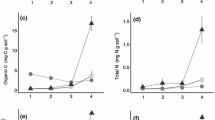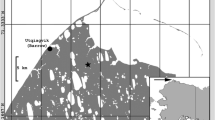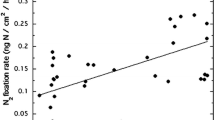Abstract
Well-constrained carbon:nitrogen:phosphorus (C:N:P) ratios in planktonic biomass, and their importance in advancing our understanding of biological processes and nutrient cycling in marine ecosystems, has motivated ecologists to search for similar patterns in terrestrial ecosystems. Recent analyses indicate the existence of “Redfield-like” ratios in plants, and such data may provide insight into the nature of nutrient limitation in terrestrial ecosystems. We searched for analogous patterns in the soil and the soil microbial biomass by conducting a review of the literature. Although soil is characterized by high biological diversity, structural complexity and spatial heterogeneity, we found remarkably consistent C:N:P ratios in both total soil pools and the soil microbial biomass. Our analysis indicates that, similar to marine phytoplankton, element concentrations of individual phylogenetic groups within the soil microbial community may vary, but on average, atomic C:N:P ratios in both the soil (186:13:1) and the soil microbial biomass (60:7:1) are well-constrained at the global scale. We did see significant variation in soil and microbial element ratios between vegetation types (i.e., forest versus grassland), but in most cases, the similarities in soil and microbial element ratios among sites and across large scales were more apparent than the differences. Consistent microbial biomass element ratios, combined with data linking specific patterns of microbial element stoichiometry with direct evidence of microbial nutrient limitation, suggest that measuring the proportions of C, N and P in the microbial biomass may represent another useful tool for assessing nutrient limitation of ecosystem processes in terrestrial ecosystems.




Similar content being viewed by others
References
Aerts R, Chapin FS III (2000) The mineral nutrition of wild plants revisited: a re-evaluation of processes and patterns. Adv Ecol Res 10:402–407
Agbenin JO, Adeniyi T (2005) The microbial biomass properties of a savanna soil under improved grass and legume pastures in northern Nigeria. Agric Ecosyst Environ 109:245–254
Arunachalam A, Arunachalam K (2000) Influence of gap size and soil properties on microbial biomass in a subtropical humid forest of north-east India. Plant Soil 223:185–193
Arunachalam A, Maithani K, Pandey HN, Tripathi RS (1996) The impact of disturbance on detrital dynamics and soil microbial biomass of a Pinus kesiya forest in north-east India. For Ecol Manage 88:273–282
Asner GP, Seastedt TR, Townsend AR (1997) The decoupling of terrestrial carbon and nitrogen cycles. Bioscience 47:226–234
Badalucco L, DeCesare F, Grego S, Landi L, Nannipieri P (1997) Do physical properties of soil affect chloroform efficiency in lysing microbial biomass? Soil Biol Biochem 29:1135–1142
Barbhuiya AR, Arunachalam A, Pandey HN, Arunachalam K, Khan ML, Nath PC (2004) Dynamics of soil microbial biomass C, N and P in disturbed and undisturbed stands of a tropical wet-evergreen forest. Eur J Soil Biol 40:113–121
Brookes PC, Powlson DS, Jenkinson DS (1982) Measurement of microbial biomass P in soil. Soil Biol Biochem 14:319–329
Brookes PC, Powlson DS, Jenkinson DS (1984) Phosphorus in the soil microbial biomass. Soil Biol Biochem 16:169–175
Brookes PC, Landman A, Pruden G, Jenkinson DS (1985) Chloroform fumigation and the release of soil nitrogen: a rapid direct extraction method to measure microbial biomass nitrogen in soil. Soil Biol Biochem 17:837–842
Chadwick OA, Derry LA, Vitousek PM, Huebert BJ, Hedin LO (1999) Changing sources of nutrients during four million years of ecosystem development. Nature 397:491–497
Chen GC, He ZL (2004) Determination of soil microbial biomass phosphorus in acid red soils from southern China. Biol Fertil Soils 39:446–451
Chen CR, Condron LM, Davis MR, Sherlock RR (2000a) Effects of afforestation on phosphorus dynamics and biological properties in a New Zealand grassland soil. Plant Soil 220:151–163
Chen GC, He ZL, Huang CY (2000b) Microbial biomass phosphorus and its significance in predicting phosphorus availability in red soils. Commun Soil Sci Plan 31:655–667
Chen CR, Condron LM, Davis MR, Sherlock RR (2003) Seasonal changes in soil phosphorus and associated microbial properties under adjacent grassland and forest in New Zealand. For Ecol Manage 177:539–557
Chen CR, Condron LM, Davis MR, Sherlock RR (2004) Effects of plant species on microbial biomass phosphorus and phosphatase activity in a range of grassland soils. Biol Fertil Soils 40:313–322
Christ MJ, David MB, McHale PJ, McLaughlin JW, Mitchell MJ, Rustad LE, Fernandez IJ (1997) Microclimatic control of microbial C, N, and P pools in Spodosol Oa horizons. Can J For Res 27:1914–1921
Cleveland CC, Townsend AR (2006) Nutrient additions to a tropical rain forest drive substantial soil carbon dioxide losses to the atmosphere. Proc Natl Acad Sci U S A 103:10316–10321
Cleveland CC, Townsend AR, Schmidt SK (2002) Phosphorus limitation of microbial processes in moist tropical forests: evidence from short-term laboratory incubations and field experiments. Ecosystems 5:680–691
Cleveland CC, Townsend AR, Constance BC, Ley RE, Schmidt SK (2004) Soil microbial dynamics in Costa Rica: seasonal and biogeochemical constraints. Biotropica 36:184–195
Cooper DJ, Watson AJ, Nightingale PD (1996) Large decrease in ocean-surface CO2 fugacity in response to in situ iron fertilization. Nature 383:511–513
Devi NB, Yadava PS (2006) Seasonal dynamics in soil microbial biomass C, N and P in a mixed-oak forest ecosystem of Manipur, north-east India. Appl Soil Ecol 31:220–227
Elser JJ, Sterner RW, Gorokhova E, Fagan WF, Markow TA, Cotner JB, Harrison JF, Hobbie SE, Odell GM, Weider LJ (2000) Biological stoichiometry from genes to ecosystems. Ecol Lett 3:540–550
Falkowski P, Scholes RJ, Boyle E et al (2000) The global carbon cycle: a test of our knowledge of earth as a system. Science 290:291–296
Falster DS, Warton DI, Wright IJ (2006) SMATR: standardised major axis tests and routines, ver2.0. http://www.bio.mq.edu.au/ecology/SMATR/
Field CB, Behrenfeld MJ, Randerson JT, Falkowski P (1998) Primary production of the biosphere: integrating terrestrial and oceanic components. Science 281:237–240
Gallardo A, Schlesinger WH (1994) Factors limiting microbial biomass in the mineral soil and forest floor of a warm-temperate forest. Soil Biol Biochem 26:1409–1415
Galloway JN, Asner G, Boyer EW et al (2004) Nitrogen cycles: past, present, and future. Biogeochemistry 70:153–226
Hecky RE, Kilham P (1988) Nutrient limitation of phytoplankton in freshwater and marine environments: a review of recent evidence on the effects of enrichment. Limnol Oceanogr 33:796–822
Hedin L (2004) Global organization of terrestrial plant-nutrient interactions. Proc Natl Acad Sci U S A 101:10849–10850
Hedley MJ, Stewart JWB (1982) Method to measure microbial phosphate in soils. Soil Biol Biochem 14:377–385
Holland KJ (2006) Fate of nitrogen in alpine tundra. Ph.D. Dissertation, University of Colorado, Boulder, CO
Ingham E, Horton K (1987) Bacterial, fungal, and protozoan responses to chloroform fumigation in stored soils. Soil Biol Biochem 19:545–550
Jenkinson DS, Powlson DS (1976) The effects of biocidal treatments on metabolism in soil. Soil Biol Biochem 8:209–213
Jenkinson DS, Brookes PC, Powlson DS (2004) Measuring soil microbial biomass. Soil Biol Biochem 36:5–7
Jenny H (1941) Factors of soil formation. McGraw Hill, New York
Joergensen RG, Kubler H, Meyer B, Wolters V (1995) Microbial biomass phosphorus in soils of beech (Fagus-Sylvatica L) forests. Biol Fertil Soils 19:215–219
Johnson AH, Frizano J, Vann DR (2003) Biogeochemical implications of labile phosphorus in forest soils determined by the Hedley fractionation procedure. Oecologia 135:487–499
Jonasson S, Michelsen A, Schmidt IK, Nielsen EV, Callaghan TV (1996) Microbial biomass C, N and P in two arctic soils and responses to addition of NPK fertilizer and sugar: implications for plant nutrient uptake. Oecologia 106:507–515
Jonasson S, Castro J, Michelsen A (2006) Interactions between plants, litter and microbes in cycling of nitrogen and phosphorus in the arctic. Soil Biol Biochem 38:526–532
Koerselman W, Meuleman AFM (1996) The vegetation N:P ratio: a new tool to detect the nature of nutrient limitation. J Appl Ecol 33:1441–1450
Kopacek J, Kana J, Santruckova H, Picek T, Stuchlik E (2004) Chemical and biochemical characteristics of alpine soils in the Tatra Mountains and their correlation with lake water quality. Water Air Soil Pollut 153:307–327
Kwabiah AB, Palm CA, Stoskopf NC, Voroney RP (2003) Response of soil microbial biomass dynamics to quality of plant materials with emphasis on P availability. Soil Biol Biochem 35:207–216
Lorenz K, Feger KH, Kandeler E (2001) The response of soil microbial biomass and activity of a Norway spruce forest to liming and drought. J Plant Nutr Soil Sci 164:9–19
Maithani K, Tripathi RS, Arunachalam A, Pandey HN (1996) Seasonal dynamics of microbial biomass C, N and P during regrowth of a disturbed subtropical humid forest in north-east India. App Soil Ecol 4:31–37
McGroddy M, Daufresne T, Hedin L (2004) Scaling of C:N:P stoichiometry in forests worldwide: implications of terrestrial Redfield-type ratios. Ecology 85:2390–2401
McIntosh PD, Gibson RS, Saggar S, Yeates GW, McGimpsey P (1999) Effect of contrasting farm management on vegetation and biochemical, chemical, and biological condition of moist steepland soils of the South Island high country, New Zealand. Aust J Soil Res 37:847–865
Morel C, Tiessen H, Stewart JWB (1996) Correction for P-sorption in the measurement of soil microbial biomass P by CHCl3 fumigation. Soil Biol Biochem 28:1699–1706
Northup BK, Brown JR, Holt JA (1999) Grazing impacts on the spatial distribution of soil microbial biomass around tussock grasses in a tropical grassland. Appl Soil Ecol 13:259–270
Oberson A, Friesen DK, Morel C, Tiessen H (1997) Determination of P released by chloroform fumigation from microbial biomass in high P sorbing tropical soils. Soil Biol Biochem 29:1579–1583
Oberson A, Friesen DK, Rao IM, Buhler S, Frossard E (2001) Phosphorus transformations in an oxisol under contrasting land-use systems: the role of the soil microbial biomass. Plant Soil 237:197–210
Okin GS, Mahowald N, Chadwick OA, Artaxo P (2004) Impact of desert dust on the biogeochemistry of phosphorus in terrestrial ecosystems. Global Biogeochem Cycles 18, GB2005
Paul EA, Clark FE (1996) Soil microbiology and biochemistry. Academic Press, San Diego
Redfield A (1958) The biological control of chemical factors in the environment. Am Sci 46:205–221
Reed SC, Cleveland CC, Townsend AR (2007) Controls over free-living nitrogen fixation in a lowland tropical rain forest. Biotropica (in press)
Reich PB, Oleksyn J (2004) Global patterns of plant leaf N and P in relation to temperature and latitude. Proc Natl Acad Sci U S A 101:11001–11006
Reiners W (1986) Complementary models for ecosystems. Am Nat 127:59–73
Reiss MJ (1989) The allometry of growth and reproduction. Cambridge University Press, Cambridge, UK
Ross D (1989) Estimation of soil microbial C by a fumigation-extraction procedure: influence of soil moisture content. Soil Biol Biochem 21:767–772
Ross D (1990) Estimation of soil microbial C by a fumigation-extraction method: influence of seasons, soils, and calibration with the fumigation-incubation procedure. Soil Biol Biochem 22:295–300
Ross DJ, Speir TW, Tate KR, Feltham CW (1997) Burning in a New Zealand snow-tussock grassland: effects on soil microbial biomass and nitrogen and phosphorus availability. N Z J Ecol 21:63–71
Ross DJ, Tate KR, Scott NA, Feltham CW (1999) Land-use change: effects on soil carbon, nitrogen and phosphorus pools and fluxes in three adjacent ecosystems. Soil Biol Biochem 31:803–813
Roy S, Singh JS (1994) Consequences of habitat heterogeneity for availability of nutrients in a dry tropical forest. J Ecol 82:503–509
Saggar S, Parfitt RL, Salt G, Skinner MF (1998) Carbon and phosphorus transformations during decomposition of pine forest floor with different phosphorus status. Biol Fertil Soils 27:197–204
Saggar S, McIntosh PD, Hedley CB, Knicker H (1999) Changes in soil microbial biomass, metabolic quotient, and organic matter turnover under Hieracium (H-pilosella L.). Biol Fertil Soils 30:232–238
Santruckova H, Vrba J, Picek T, Kopacek J (2004) Soil biochemical activity and phosphorus transformations and losses from acidified forest soils. Soil Biol Biochem 36:1569–1576
Sarathchandra SU, Perrott KW, Littler RA (1989) Soil microbial biomass—influence of simulated temperature-changes on size, activity and nutrient-content. Soil Biol Biochem 21:987–993
Sarig S, Fliessbach A, Steinberger Y (1996) Microbial biomass reflects a nitrogen and phosphorous economy of halophytes grown in salty desert soil. Biol Fertil Soils 21:128–130
Schilling EB, Lockaby BG (2005) Microsite influences on productivity and nutrient circulation within two southeastern floodplain forests. Soil Sci Soc Am J 69:1185–1195
Schmidt IK, Jonasson S, Shaver GR, Michelsen A, Nordin A (2002) Mineralization and distribution of nutrients in plants and microbes in four arctic ecosystems: responses to warming. Plant Soil 242:93–106
Sharma P, Rai SC, Sharma R, Sharma E (2004) Effects of land-use change on soil microbial C, N and P in a Himalayan watershed. Pedobiologia 48:83–92
Singh S, Singh JS (1995) Microbial biomass associated with water-stable aggregates in forest, savanna and cropland soils of a seasonally dry tropical region, India. Soil Biol Biochem 27:1027–1033
Singh RS, Srivastava SC, Raghubanshi AS, Singh JS, Singh SP (1991) Microbial-C, microbial-N and microbial-P in dry tropical savanna—effects of burning and grazing. J Appl Ecol 28:869–878
Singh KP, Mandal TN, Tripathi SK (2001) Patterns of restoration of soil physicochemical properties and microbial biomass in different landslide sites in the sal forest ecosystem of Nepal Himalaya. Ecol Eng 17:385–401
Sjursen HS, Michelsen A, Holmstrup M (2005) Effects of freeze-thaw cycles on microarthropods and nutrient availability in a sub-Arctic soil. App Soil Ecol 28:79–93
Sparling G, West A (1989) Importance of soil water content when estimating soil microbial C, N and P by the fumigation-extraction methods. Soil Biol Biochem 21:245–253
Sparling GP, Hart PBS, August JA, Leslie DM (1994) A comparison of soil and microbial carbon, nitrogen, and phosphorus contents, and macro-aggregate stability of a soil under native forest and after clearance for pastures and plantation forest. Biol Fertil Soils 17:91–100
Srivastava SC (1998) Microbial contribution to extractable N and P after air-drying of dry tropical soils. Biol Fertil Soils 26:31–34
Srivastava SC, Singh JS (1988) Carbon and phosphorus in the soil biomass of some tropical soils of India. Soil Biol Biochem 20:743–747
Srivastava SC, Singh JS (1991) Microbial-C, microbial-N and microbial-P in dry tropical forest soils—effects of alternate land-uses and nutrient flux. Soil Biol Biochem 23:117–124
Stark S, Grellmann D (2002) Soil microbial responses to herbivory in an arctic tundra heath at two levels of nutrient availability. Ecology 83:2736–2744
Stark S, Strommer R, Tuomi J (2002) Reindeer grazing and soil microbial processes in two suboceanic and two subcontinental tundra heaths. Oikos 97:69–78
Sterner RW, Elser JJ (2002) Ecological stoichiometry: The biology of elements from molecules to the biosphere. Princeton University, Princeton
Townsend AR, Cleveland CC, Asner GP, Bustamante MMC (2007) Controls of foliar N:P ratios in tropical rain forests. Ecology 88:107–118
Turner BL, Bristow AW, Haygarth PM (2001) Rapid estimation of microbial biomass in grassland soils by ultra-violet absorbance. Soil Biol Biochem 33:913–919
Vitousek PM, Howarth RW (1991) Nitrogen limitation on land and sea: how can it occur? Biogeochemistry 13:87–115
Waksman S, Starkey R (1931) The soil and the microbe. Wiley, London
Walker TW, Syers JK (1976) The fate of phosphorus during pedogenesis. Geoderma 15:1–19
Wang FE, Chen YX, Tian GM, Kumar S, He YF, Fu QL, Lin Q (2004) Microbial biomass carbon, nitrogen and phosphorus in the soil profiles of different vegetation covers established for soil rehabilitation in a red soil region of southeastern China. Nutr Cycl Agroecosys 68:181–189
Wardle DA (1992) A comparative assessment of factors which influence microbial biomass carbon and nitrogen levels in soil. Biol Rev 67:321–358
Wardle DA (1998) Controls of temporal variability of the soil microbial biomass: a global-scale synthesis. Soil Biol Biochem 30:1627–1637
Warton DI, Wright DS, Westoby M (2006) Bivariate line-fitting methods for allometry. Biol Rev 81:259–291
West AW, Ross DJ, Cowling JC (1986) Changes in microbial C, N, P and ATP contents, numbers and respiration on storage of soil. Soil Biol Biochem 18:141–148
Wright CJ, Coleman DC (2000) Cross-site comparison of soil microbial biomass, soil nutrient status, and nematode trophic groups. Pedobiologia 44:2–23
Yavitt JB, Wieder RK, Wright SJ (1993) Soil nutrient dynamics in response to irrigation of a Panamanian tropical moist forest. Biogeochemistry 19:1–25
Yeates GW, Saggar S (1998) Comparison of soil microbial properties and fauna under tussock-grassland and pine plantation. J Roy Soc New Zeal 28:523–535
Acknowledgments
We thank Loren Sackett and Christine Fairbanks for assistance with the literature search, and Noah Fierer, Alan Townsend, Josh Schimel and two anonymous reviewers for valuable comments on the manuscript. C. C. was supported by a grant from the National Science Foundation (DEB-0515744). D.L. was supported by grants from the NSF Long-Term Ecological Research (LTER) program (DEB-9810128).
Author information
Authors and Affiliations
Corresponding author
Appendix
Appendix
Rights and permissions
About this article
Cite this article
Cleveland, C.C., Liptzin, D. C:N:P stoichiometry in soil: is there a “Redfield ratio” for the microbial biomass?. Biogeochemistry 85, 235–252 (2007). https://doi.org/10.1007/s10533-007-9132-0
Received:
Accepted:
Published:
Issue Date:
DOI: https://doi.org/10.1007/s10533-007-9132-0




